Curtains
This is how to measure for curtains
Measuring for curtains may seem daunting, but we’ll explain just how easy it is…
First things first, before measuring, you should decide on the preferred fitting style for your curtains.
Floor-length fitting is very common and is the go-to for most homeowners and interior designers. Typically, floor-length fitting creates a small gap from curtain bottom to floor which helps deliver spectacular uniformity while ensuring the fabric is less prone to wear and tear. However, you may like the idea of a fuller length look where the curtain is made a little longer than the drop so the fabric gathers (or as it’s often called, ‘puddles’) on the floor.
Correct measuring is the key to easy, hassle-free installation. So, it’s worth taking the time to get it right.
All our curtains are made to exactly fit the track they are hung from, and all our curtains are underslung on their tracks. So, it’s worth noting that your track will be partially visible above the curtain after installation.
Additionally, our curtains are made with about 200% fullness (or about 180% for pinch pleat and double S-fold curtains). You do not need to make any adjustments for curtain fullness – we just need the desired track width to make sure your chosen curtains fit beautifully!
Measuring for width
Whenever possible, the curtain track should be a little wider than the window or doorway it’s covering. This helps ensure the curtain elegantly frames the recess and the stacking does not cover too much of the glass when drawn open. The average stacking for any curtain we make is always 30% of the total width.
With this in mind, we recommend adding at least 150mm and up to 300mm to the width measurement on each side of the frame. For example, if your measurement from left to right of the frame is 2500mm, your final measurement to enter when ordering would include the extra 150mm for the left and the extra 150mm for the right side, giving you 2800mm (or more if you decide to extend the track further on one or each side).
Measuring for height
There are two fixing options to consider before you commence measuring for curtain height.
Face fixing is where the track and brackets are mounted to the wall. Face fixing is typically used to counter the impact of a cornice while also providing some extra wriggle room when it comes to installation.
For face fixing, measure where you want the top of the track to sit on the wall (we recommend at least 150mm above the existing frame), down to the floor. With this measurement recorded, deduct 10mm before ordering which helps ensure the curtain sits a little off the floor, even after the fabric settles. For example, if your measurement from the top of track to the floor comes out at 2500mm, your final measurement to enter when ordering would be 2490mm.
Top fixing is where the track and brackets are mounted from the ceiling itself. This is typically used to create a dramatic ‘floor to ceiling’ effect, which is possible when there’s no cornice to contend with. However, it is also worth noting that unlike face fixing, your fitting position is not adjustable when you top fix from the ceiling.
For top fixing, simply measure from the ceiling surface to floor and make a 20mm deduction before ordering. For example, if your measurement from the ceiling to floor comes out at 2500mm, your final measurement to enter when ordering would be 2480mm.
For either fixing, don’t worry about allowing for the track height while measuring. Once we receive your order, we’ll make a standard 15mm deduction for this.
Once you’ve recorded your width and drop measurements, head to the relevant curtain product page, add all your details in the Customise & Order area and before you know it, your beautiful custom-fit curtains will be delivered to your door!
If you would prefer to watch this guide in video form, please click on the video thumbnail found at the very top of this page.
And of course, if you’re in anyway unsure of how to proceed with measuring, please get in touch and we’ll be happy to provide specific advice.
